We can’t talk about the modern education system without mentioning the lockdowns that occurred during the height of the Covid-19 pandemic in 2020 and 2021.
In the post-pandemic world, we know the limitations of traditional schooling better than ever before.
We know that there are only so many hours in a single day, and one physical classroom can’t accommodate the educational needs of all students.
That’s why we’re starting to see the emergence of a new concept: global schooling.
Limitations of Traditional Schooling
 The world is becoming globalized. And the traditional approach to schooling is becoming increasingly inadequate to meet the needs of students around the world.
The world is becoming globalized. And the traditional approach to schooling is becoming increasingly inadequate to meet the needs of students around the world.
According to a survey of over 3,000 people conducted by Tyton Partners, 6 out of 10 parents believe that educational preferences have changed post-pandemic. The need for more control, flexibility and personalization in the learning experience is becoming increasingly apparent by the day.
Some of the things the traditional schooling system is lacking include:
- Consistency: We’ve seen how easily the traditional school system can fall apart. We don’t know when another world-changing event will happen. Researchers agree that even short interruptions in learning can lead to long-lasting negative effects on the educational, social, as well as emotional well-being of children.
- Individualization: The lack of individualization in the school system isn’t anything new. As a matter of fact, the problem has been discussed since the 1970s. With the need for customized study plans, the traditional schooling system is unable to meet the needs of each student.
- Diversity: Learning about different countries, histories, and cultures have been a problem for quite a while. With classrooms filled with students of different backgrounds, it’s obvious that the traditional system lacks the diversity needed in the modern world.
Now, when we say that the school system lacks diversity, we’re not talking about the students. The classrooms are more diverse than ever.
Rather, we’re talking about the fact that students often don’t have the opportunity to learn about the world beyond the one that surrounds them.
What’s Global Schooling?
In the past, families looking for study and work opportunities had to move abroad to find them. Research before the pandemic showed that there were more than 10,000 international schools around the globe, with nearly 5.4 million students enrolled.
However, international education nowadays is much more attainable. The lockdowns not only showed that eLearning is feasible and effective but also that students can also benefit from experiencing schooling around the world.
In Asia, for example, the demand for “Western-style education” has led many students to start visiting American and European learning platforms. For instance, 24HourAnswers, a platform that provides answers to students’ academic questions, saw a surge in traffic from places like Japan, China, and India.
The schools definitely noticed that modern students want opportunities to learn from several sources and perspectives. It’s time for parents and schools to start adjusting to the new reality and provide students with the global exposure they need.
How Global Schooling Could Help Students

So far, we’ve established that learning about new cultures and perspectives is crucial for success in the modern world. Students need to prepare themselves to collaborate with a multicultural workforce and to understand the nuances of international relations.
But we’ve just scratched the surface. There are many more benefits to global learning, including:
● Flexibility
 Different students, naturally, have different learning styles, schedules, and goals. Constraining the students to a single location, fixed timetable, and defined curriculum can limit their educational potential.
Different students, naturally, have different learning styles, schedules, and goals. Constraining the students to a single location, fixed timetable, and defined curriculum can limit their educational potential.
Not to mention that we’re discovering that there are more students with sensory issues than we thought. These students would greatly benefit from working with specialists that could personalize their learning experience.
● Selection
 With large migrations across Europe and Asia, schools look more diverse than ever. It’s estimated that in high-income countries, around 15% of students are now from migrant backgrounds.
With large migrations across Europe and Asia, schools look more diverse than ever. It’s estimated that in high-income countries, around 15% of students are now from migrant backgrounds.
While a new country can give these students access to the education they need, a lot of them would still like to have an opportunity to learn about their home country and ancestor culture.
Connecting with teachers from their native land in their native language can help them make sense of their roots. That way, they can establish a healthier relationship with a place that shaped their parents.
● Accessibility
 Students in remote areas have had problems accessing quality education all throughout history. With no need to commute from one place to another, remote and online learning has democratized education.
Students in remote areas have had problems accessing quality education all throughout history. With no need to commute from one place to another, remote and online learning has democratized education.
New technological advancements can help this process further by allowing students from all four corners of the globe to attend virtual classes in Metaverse-inspired classrooms.
Last year, Jeremy Bailenson, the director of Stanford’s Virtual Human Interaction Lab, started teaching a VR class called “Virtual People.” Already, 260 people have been enrolled.
● Globalization
 According to research from the World Economic Forum, the Asia Pacific region, followed by Europe, North, and Latin America, has had the biggest presence on learning platforms. Other regions will undoubtedly soon follow suit.
According to research from the World Economic Forum, the Asia Pacific region, followed by Europe, North, and Latin America, has had the biggest presence on learning platforms. Other regions will undoubtedly soon follow suit.
Experts in different fields aren’t concentrated in a single part of the world anymore. Leading STEM researchers are mainly located in Asia, the best programmers tend to be located in Europe, and so on and so forth.
Giving students access to the best professionals globally can help them learn more quickly and maximize their potential. Whether looking for help with math homework or trying to learn how to program in Python, global education platforms can give students access to educational materials from around the world.
The Future of Schooling
In the end, what are we proposing? Should all schools move online and start offering fully customized learning programs for students? Not at all. That would be far too drastic of a change, and since students need to socialize, this approach could be counterproductive.
However, it’s undeniable that the global approach to education has many benefits for today’s learners. The question is, when will we be ready to move beyond the traditional system and take advantage of what the world has to offer?
No matter what form global schooling takes, this new approach can and will help students more than it will hurt them.



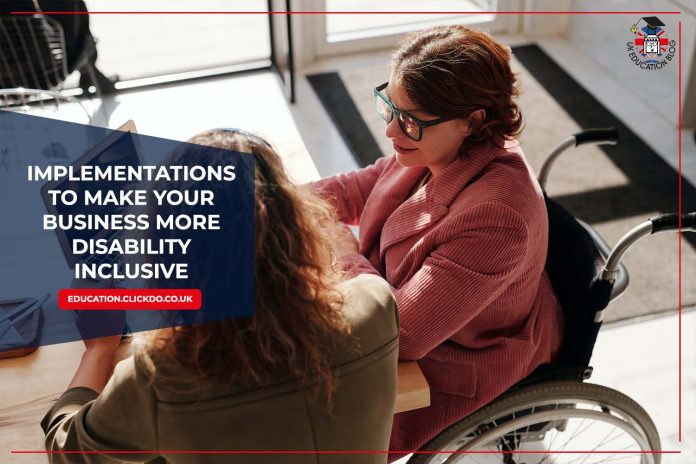
 Most people without a disability don’t think about the considerations a disabled person has to make when choosing a business to fulfill their needs. Those with wheelchairs and reduced mobility will tend to opt for those with the most accessible parking spaces. This applies to everything from shops and cinemas to law firms and accountants. Parking in a busy town or city can be difficult for anyone, but for people with disabilities, it is often a dealbreaker.
Most people without a disability don’t think about the considerations a disabled person has to make when choosing a business to fulfill their needs. Those with wheelchairs and reduced mobility will tend to opt for those with the most accessible parking spaces. This applies to everything from shops and cinemas to law firms and accountants. Parking in a busy town or city can be difficult for anyone, but for people with disabilities, it is often a dealbreaker. Those with mobility impairments must be able to get around easily, both outside and inside your store or offices. Ensure all pathways are wide enough for wheelchairs, crutches, guide dogs, or human assistants.
Those with mobility impairments must be able to get around easily, both outside and inside your store or offices. Ensure all pathways are wide enough for wheelchairs, crutches, guide dogs, or human assistants.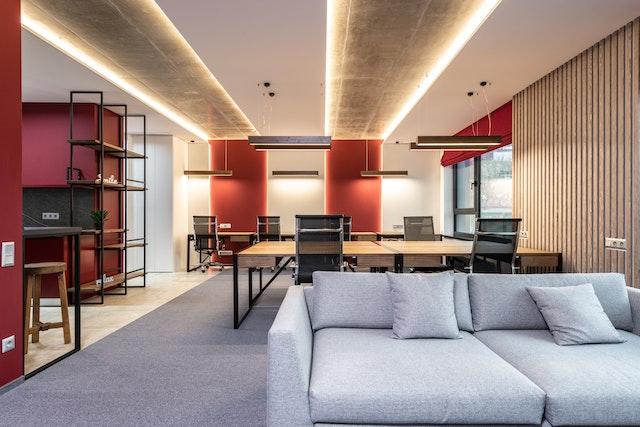 There are far too many trendy stores and restaurants that attempt to create an atmosphere by keeping the lighting as low as possible. For many consumers, this is a minor annoyance, but for people with vision impairments or reduced mobility, it can be a real danger.
There are far too many trendy stores and restaurants that attempt to create an atmosphere by keeping the lighting as low as possible. For many consumers, this is a minor annoyance, but for people with vision impairments or reduced mobility, it can be a real danger.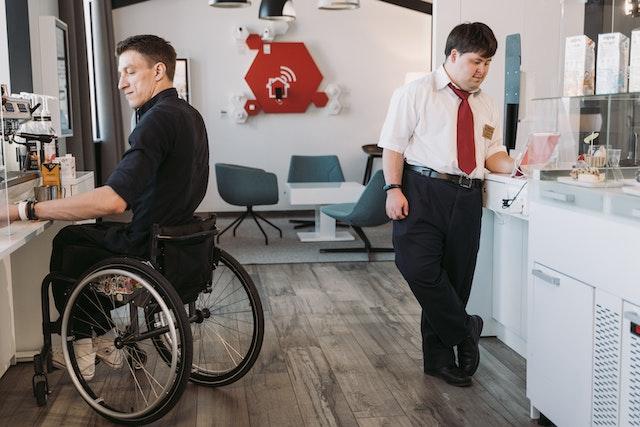 A lot of businesses play loud music at all times of the day, but this can be incredibly distressing for those who are hard of hearing. It makes it far more difficult for them to have a conversation or get help from a member of staff.
A lot of businesses play loud music at all times of the day, but this can be incredibly distressing for those who are hard of hearing. It makes it far more difficult for them to have a conversation or get help from a member of staff. If you own a shop, you want disabled people to be able to reach the products they need without help. High shelves are a major inconvenience for those in wheelchairs, little people, and others who may have trouble seeing or reaching the products on display. Generally, anything above four feet off the ground is not going to be accessible for many people.
If you own a shop, you want disabled people to be able to reach the products they need without help. High shelves are a major inconvenience for those in wheelchairs, little people, and others who may have trouble seeing or reaching the products on display. Generally, anything above four feet off the ground is not going to be accessible for many people. Navigating public toilets can be difficult for disabled people, especially if they are in an unfamiliar building or location and don’t know what the facilities are like. Some disabilities mean an individual will need to use the toilet more often than most, so it’s important you have accessible bathrooms to cater to the disabled.
Navigating public toilets can be difficult for disabled people, especially if they are in an unfamiliar building or location and don’t know what the facilities are like. Some disabilities mean an individual will need to use the toilet more often than most, so it’s important you have accessible bathrooms to cater to the disabled.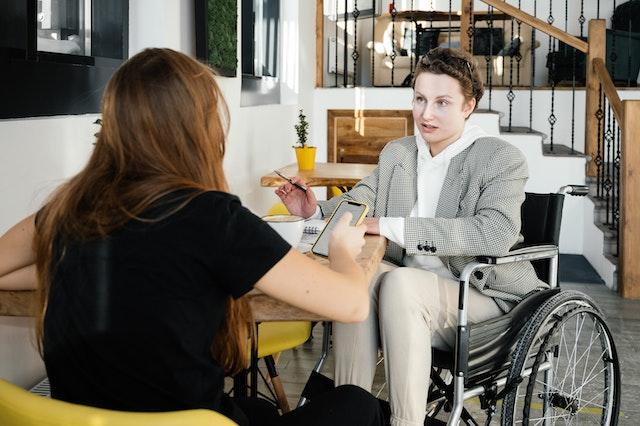 Some members of your staff may not know people with disabilities or be aware of the challenges they face. Although they no doubt mean well, this may make it difficult for them to provide the service a disabled person may need. It’s possible they may display signs of ableism – whether intentional or not – that can make someone with a disability feel unwelcome and insulted.
Some members of your staff may not know people with disabilities or be aware of the challenges they face. Although they no doubt mean well, this may make it difficult for them to provide the service a disabled person may need. It’s possible they may display signs of ableism – whether intentional or not – that can make someone with a disability feel unwelcome and insulted. When thinking about accessibility, most business owners don’t consider the importance of their company website. But using the internet is a challenge for many disabled people, especially those with vision impairments, reduced motor function, or learning difficulties like dyslexia.
When thinking about accessibility, most business owners don’t consider the importance of their company website. But using the internet is a challenge for many disabled people, especially those with vision impairments, reduced motor function, or learning difficulties like dyslexia. It’s not only important that your business is inclusive to its customers, but also to its employees. There’s a high chance that one or more of your staff have a disability, so as an employer, you must be sensitive to that fact. It is your responsibility as an employer to cultivate a work environment that is transparent, positive, and inclusive.
It’s not only important that your business is inclusive to its customers, but also to its employees. There’s a high chance that one or more of your staff have a disability, so as an employer, you must be sensitive to that fact. It is your responsibility as an employer to cultivate a work environment that is transparent, positive, and inclusive.
 1. Better Physical Health
1. Better Physical Health Standing desks can help to improve students’ and educators’ physical health by reducing the amount of time they spend sitting in one position. This can help to reduce the risk of developing poor posture, back pain, and other health problems associated with prolonged sitting.
Standing desks can help to improve students’ and educators’ physical health by reducing the amount of time they spend sitting in one position. This can help to reduce the risk of developing poor posture, back pain, and other health problems associated with prolonged sitting.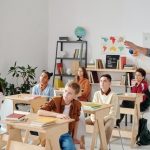 Standing desks can help to improve student and educator focus by allowing them to move around and change positions throughout the day. This can help to reduce fatigue and increase engagement in the classroom.
Standing desks can help to improve student and educator focus by allowing them to move around and change positions throughout the day. This can help to reduce fatigue and increase engagement in the classroom. Standing desks can help to improve students’ and educators’ posture by encouraging them to stand upright and maintain good posture while at school. This can help to reduce the risk of developing poor posture, which can lead to a variety of health problems.
Standing desks can help to improve students’ and educators’ posture by encouraging them to stand upright and maintain good posture while at school. This can help to reduce the risk of developing poor posture, which can lead to a variety of health problems. Standing desks can help to increase student and educator productivity by encouraging physical activity which stimulates the mind and brain activity. Engaging in theoretical activities combined with physical movement activates muscle memory as well.
Standing desks can help to increase student and educator productivity by encouraging physical activity which stimulates the mind and brain activity. Engaging in theoretical activities combined with physical movement activates muscle memory as well. Standing desks can help to increase energy levels in the classroom by allowing students and educators to move around and get their blood circulating. This can help to keep students alert and focused, leading to better learning outcomes.
Standing desks can help to increase energy levels in the classroom by allowing students and educators to move around and get their blood circulating. This can help to keep students alert and focused, leading to better learning outcomes. Standing up when answering questions,
Standing up when answering questions, 
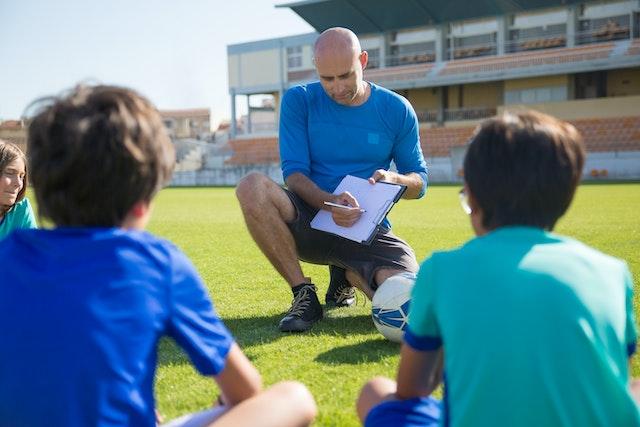 Football training can start at the age of 4. As a parent, you must focus on your child’s training, exercise, and nutrition.
Football training can start at the age of 4. As a parent, you must focus on your child’s training, exercise, and nutrition. Once you have tested the waters with football schools and think your child has what it takes, send them to a high-performance football boarding school.
Once you have tested the waters with football schools and think your child has what it takes, send them to a high-performance football boarding school. Once your child has the training needed, it’s time to test their abilities on the field.
Once your child has the training needed, it’s time to test their abilities on the field. Football is a team sport, so if you want to play and learn the game, you must join a team.
Football is a team sport, so if you want to play and learn the game, you must join a team. It is a good idea to put together a CV listing your:
It is a good idea to put together a CV listing your: Football, like many other professions, places a strong emphasis on networking. An agent can help you make contacts within the industry.
Football, like many other professions, places a strong emphasis on networking. An agent can help you make contacts within the industry. A prospective footballer’s club trial might be one of the most important moments in their career.
A prospective footballer’s club trial might be one of the most important moments in their career. You can also try for a football scholarship at a university. You will get to play on the team and receive higher education.
You can also try for a football scholarship at a university. You will get to play on the team and receive higher education. You will work at the grassroots level.
You will work at the grassroots level.
 The perfect job for football fanatics.
The perfect job for football fanatics. Do you have an undying love for the game? Work as a scout and you can see thousands of players of all ages and levels over a season and unearth tomorrow’s talent.
Do you have an undying love for the game? Work as a scout and you can see thousands of players of all ages and levels over a season and unearth tomorrow’s talent.
 Source
Source Source
Source Teachers can design their own question papers and question sets and they can create various games. Students can sign up using a code and participate in real-time quizzes using their phones or other devices, after which they can easily play games. All the games on Blooket are completely safe and secure for all age
Teachers can design their own question papers and question sets and they can create various games. Students can sign up using a code and participate in real-time quizzes using their phones or other devices, after which they can easily play games. All the games on Blooket are completely safe and secure for all age Blooket is very convenient and user-friendly for students to use and access in the classroom or at home. After creating an account, all students need to do to get started is submit their nickname and icon, along with the game ID for the game or activity their teacher assigned.
Blooket is very convenient and user-friendly for students to use and access in the classroom or at home. After creating an account, all students need to do to get started is submit their nickname and icon, along with the game ID for the game or activity their teacher assigned. The teacher cannot read every question because each student is working at their own pace, and there is no immersive reader built in. This makes this website a good option only for older students.
The teacher cannot read every question because each student is working at their own pace, and there is no immersive reader built in. This makes this website a good option only for older students. For each game, you can choose whether you want each game to stop when someone reaches a given score or at a specific time (for example, giving students 7 minutes to play). The game will go on till the time you specify. This implies that, unless there are many questions in the set, students who answer quickly will see the same questions repeated again.
For each game, you can choose whether you want each game to stop when someone reaches a given score or at a specific time (for example, giving students 7 minutes to play). The game will go on till the time you specify. This implies that, unless there are many questions in the set, students who answer quickly will see the same questions repeated again. If you come across a set of questions that are close to what you need but not perfect, you will need to make your own set of questions. Hence teachers cannot
If you come across a set of questions that are close to what you need but not perfect, you will need to make your own set of questions. Hence teachers cannot With Blooket, you can revolutionize the classroom learning experience in several ways. It is a fun game that helps everyone study more effectively and allows teachers to spend more time with their students.
With Blooket, you can revolutionize the classroom learning experience in several ways. It is a fun game that helps everyone study more effectively and allows teachers to spend more time with their students.
 Source
Source
 Source
Source Source
Source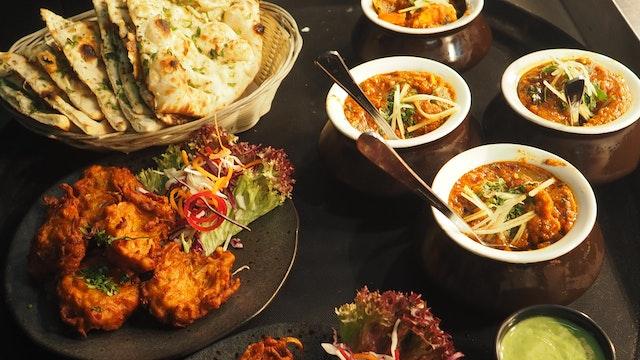 Households are spending £62/week on food and 51/week on restaurants. Eating in restaurants is not an option on your budget.
Households are spending £62/week on food and 51/week on restaurants. Eating in restaurants is not an option on your budget. The major household bills you need to pay are electricity, heat, and water, about £80/per week for an average household.
The major household bills you need to pay are electricity, heat, and water, about £80/per week for an average household. Abandon your dreams of a car. There is no set figure of what you can cut your transport costs too because it depends on where you can commute. A household spends £80/week on commuting. Which means one person spends £80/month.
Abandon your dreams of a car. There is no set figure of what you can cut your transport costs too because it depends on where you can commute. A household spends £80/week on commuting. Which means one person spends £80/month. Source
Source Source
Source




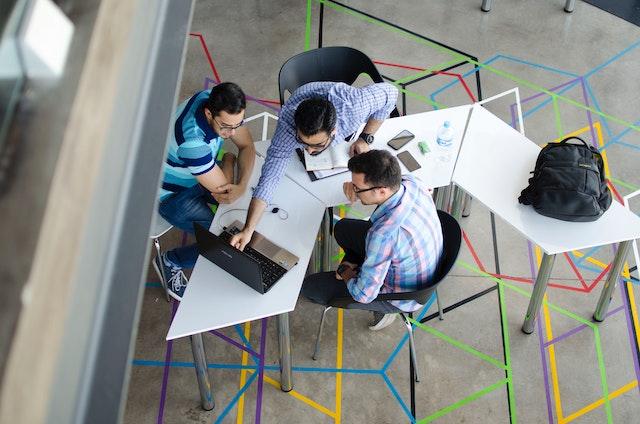












 Workers can sometimes view online training as a mandatory chore. The things that they learn may not truly be valued or even remembered.
Workers can sometimes view online training as a mandatory chore. The things that they learn may not truly be valued or even remembered. While many people are content in their roles, others are hungry for further opportunities. The right eLearning course provider can be a gateway to those all-important prospects.
While many people are content in their roles, others are hungry for further opportunities. The right eLearning course provider can be a gateway to those all-important prospects. eLearning courses can come from anywhere. Engaging with them gives people a broader range of teachings and considerations to mull over.
eLearning courses can come from anywhere. Engaging with them gives people a broader range of teachings and considerations to mull over.